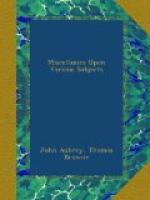While Edward, Duke of York,* was declaring his title, in the Chamber of the Peers, there happened a strange chance, in the very same time, amongst the Commons in the nether house, then there assembled: for a Crown, which did hang in the middle of the same, to garnish a branch to set lights upon, without touch of any creature, or rigor of wind, suddenly fell down, and at the same time also, fell down the Crown, which stood on the top of the Castle of Dover: as a sign and prognostication, that the Crown of the realm should be divided and changed from one line to another. Halle’s Chronicle, H. 6. F. 181.
* Father of Edward IV.
Anno 1506. Through great tempest of wind in January, Philip, King of Castille and his wife, were weather-driven and landed at Falmouth. This tempest blew down the Eagle of Brass from the spire of St. Paul’s church in London, and in the falling, the same eagle broke and battered the black Eagle* which hung for a sign in St. Paul’s Church-yard. Stow’s Annals, 484.
* The black Eagle is the cognizance of the house of Austria, of which Philip was head.
The silver cross that was wont to be carried before Cardinal Wolsey, fell out of its socket, and was like to have knocked out the brains of one of the Bishop’s servants. A very little while after, came in a messenger, and arrested the Cardinal, before he could get out of the house. See Stow’s Chronicle.
’Tis commonly reported, that before an heir of the Cliftons, of Clifton in Nottinghamshire, dies, that a Sturgeon is taken in the river Trent, by that place.
Thomas Flud, Esq. in Kent, told me that it is an old observation which was pressed earnestly to King James I. that he should not remove the Queen of Scots body from Northamptonshire, where she was beheaded and interred: for that it always bodes ill to the family when bodies are removed from their graves. For some of the family will die shortly after, as did Prince Henry, and I think Queen Ann.
A little before the death of Oliver, the Protector, a Whale came into the river Thames, and was taken at Greenwich, —– feet long. ’Tis said Oliver was troubled at it.
When I was a freshman at Oxford, 1642, I was wont to go to Christ Church, to see King Charles I. at supper; where I once heard him say, " That as he was hawking in Scotland, he rode into the quarry, and found the covey of partridges falling upon the hawk; and I do remember this expression further, viz. and I will swear upon the book ’tis true.” When I came to my chamber, I told this story to my tutor; said he, that covey was London.
The bust of King Charles I. carved by Bernini, as it was brought in a boat upon the Thames, a strange bird (the like whereof the bargemen had never seen) dropped a drop of blood, or blood-like, upon it; which left a stain not to be wiped off. This bust was carved from a picture of Sir Anthony Van Dyke’s drawing: the sculptor found great fault with the fore-head as most unfortunate. There was a seam in the middle of his fore-head, (downwards) which is a very ill sign in Metoposcopie.




